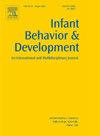Relationship between temperamental dimensions and infant limb movement complexity and dynamic stability
IF 1.9
3区 心理学
Q3 PSYCHOLOGY, DEVELOPMENTAL
引用次数: 0
Abstract
Infant temperament reflects behavioral responses to stimulation, while the motor system undergoes significant developmental changes throughout infancy, influenced in part by caregivers’ mental well-being. This study examines the associations between temperament and motor system organization across three distinct social interaction tasks at 6 and 12 months of age. To account for the role of the caregiver’s mental well-being, we also included maternal trait anxiety in our analysis. A longitudinal sample of 83 infants at 6 months and 59 infants at 12 months participated in three caregiver-infant tasks: book-sharing, playing with manipulative toys, and rattle-shaking. Infant limb movements were recorded using wearable accelerometers, and we applied Multidimensional Recurrence Quantification Analysis (MdRQA) to extract Entropy (reflecting motor system complexity) and Mean Line (reflecting motor system stability). Using mixed-effects models, we examined the predictive effects of task and temperament variables: Negative Affectivity (NEG), Positive Affectivity or Surgency (PAS), and Orienting and Regulatory Capacity (ORC). Our results suggest that Negative Affectivity measured at 6 months predicted increased motor system Entropy and Mean Line concurrently at 6 months as well as longitudinally at 12 months. Temperamental variables measured at 12 months of age did not predict infants’ motor systems’ complexity and stability at the same time point. At 12 months, task conditions modulated both Entropy and Mean Line, suggesting greater sensitivity to contextual differences later in infancy. Additionally, higher maternal trait anxiety (measured at 4 months) predicted decreased motor system Entropy and Mean Line at 12 months. Our results have implications for understanding the early developmental pathways of motor system organization, its relationship with temperament, and the influence of caregiver mental well-being on infant motor development.
气质维度与婴儿肢体运动复杂性和动态稳定性的关系
婴儿气质反映了对刺激的行为反应,而运动系统在整个婴儿期经历了显著的发育变化,部分受照顾者心理健康的影响。本研究考察了6个月和12个月大的婴儿在三个不同的社会互动任务中气质和运动系统组织之间的关系。为了解释照顾者心理健康的作用,我们还在分析中纳入了母亲特质焦虑。对83名6个月大的婴儿和59名12个月大的婴儿进行纵向抽样,让他们参与三个看护人与婴儿之间的任务:分享书籍、玩操纵性玩具和摇摇摇铃。使用可穿戴式加速度计记录婴儿肢体运动,并应用多维递归量化分析(MdRQA)提取熵(反映运动系统复杂性)和均值线(反映运动系统稳定性)。采用混合效应模型,研究了负性情感(NEG)、正性情感或应急(PAS)和定向与调节能力(ORC)这三个任务变量和气质变量的预测作用。我们的研究结果表明,在6个月时测量的负情感可以同时预测6个月时和12个月时运动系统熵和均线的增加。在12个月大时测量的情绪变量并不能预测婴儿运动系统在同一时间点的复杂性和稳定性。在12个月大的时候,任务条件调节了熵值和平均值,表明在婴儿期后期对环境差异更敏感。此外,较高的母亲特质焦虑(在4个月时测量)预示着12个月时运动系统熵和均线的下降。我们的研究结果有助于理解运动系统组织的早期发育途径、运动系统组织与气质的关系以及照顾者心理健康对婴儿运动发育的影响。
本文章由计算机程序翻译,如有差异,请以英文原文为准。
求助全文
约1分钟内获得全文
求助全文
来源期刊

Infant Behavior & Development
PSYCHOLOGY, DEVELOPMENTAL-
CiteScore
4.10
自引率
4.80%
发文量
94
期刊介绍:
Infant Behavior & Development publishes empirical (fundamental and clinical), theoretical, methodological and review papers. Brief reports dealing with behavioral development during infancy (up to 3 years) will also be considered. Papers of an inter- and multidisciplinary nature, for example neuroscience, non-linear dynamics and modelling approaches, are particularly encouraged. Areas covered by the journal include cognitive development, emotional development, perception, perception-action coupling, motor development and socialisation.
 求助内容:
求助内容: 应助结果提醒方式:
应助结果提醒方式:


